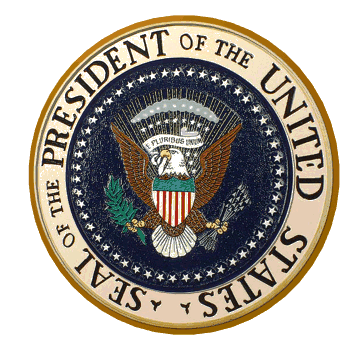 TheUSAPresidents.com
TheUSAPresidents.com 
 TheUSAPresidents.com
TheUSAPresidents.com 
 We have pages on every president!
We have pages on every president!

Presumably a White House photographer, Public domain, via Wikimedia Commons
Predecessor and Successor
← Harry Truman | John F. Kennedy →
Party
Term Dates
January 20, 1953 - January 20, 1961
Dwight David Eisenhower was a military general who served as the 34th president of the United States of America. He was previously the commander of all Allied forces in World War Two. In 1952, he was finally convinced to run for president. He identified as a Republican, but he likely would have been elected no matter what. He was the first Republican president in twenty years. During his presidency, the Korean War officially ended. Eisenhower also agreed with the Truman Doctrine and was firm with the Soviet Union. He had a well known campaign slogan, "I Like Ike". Ike was a nickname that Eisenhower had. He is considered one of the more underrated presidents, due to the fact that the economy, military and overall country remained strong.
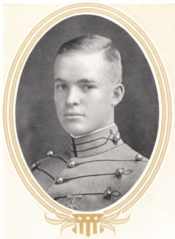
Eisenhower was born on October 14, 1890 in Denison, Texas. His original name was David Dwight Eisenhower, but his dad was also named David. Therefore, his first and middle names were switched, and he became Dwight David Eisenhower. His family was very religious, his mother becoming what is known today as a Jehovah's Witness. From an early age, Eisenhower enjoyed the outdoors, learning things like camping and how to play cards. Eisenhower as a child became interested in his mother's war books, which contributed to his decision to be in the military. He received average grades in school. He was appointed to West Point to play football, until he suffered a devastating knee injury. It was so bad, in fact, that his doctor recommended it to be amputated, but Eisenhower refused. Eisenhower then joined the military.
While he did not play a big role, Eisenhower still served during World War I. When the United States joined the war, he requested to partake in overseas missions. He was denied this, and was instead sent to Kansas. After then transferring to Camp Meade in Maryland, he joined a unit which would eventually be a tank corps. Eisenhower was looking forward to going overseas, hoping his unit would be assigned to go fight in Europe. He got his wish when he was ordered to go to France, but just one week after the order, the war ended with Germany's armistice. Though he received the Distinguished Service Medal, Eisenhower was not happy that he did not get to go overseas. Nevertheless, after the war, he reverted back to a captain, but became a major only days later. He would continue to be a major for a long time, and returned to Camp Meade. He now learned a lot more about tanks, and was able to connect with other tank leaders, notably one George S. Patton. The objective for Eisenhower was to be prepared for the next war. The Great Depression would later hurt this, though. In 1935, Eisenhower would join Douglas MacArthur to the Philippines to help develop their army. It is here when Eisenhower began to disagree with a lot of things MacArthur thought, and the two would forever be distant from each other. In late 1939, Eisenhower returned to the United States, and he became the commanding officer of the 1st Battalion, 15th Infantry Regiment. He then became regimental executive officer of the same battalion. In March 1941, he became colonel of the IX Corps, and then became the chief of staff of the commander of the third army in June. Eisenhower played a part in the Louisiana Maneuvers, which were a series of exercises and training held to test US soldiers based in Louisiana. Since Eisenhower had a role in it, he became a brigadier general.
When the United States joined World War II, Eisenhower became a member of the General Staff located in Washington, D.C., which planned how to defeat Japan and Germany. He then became Deputy Chief of the pacific section of the War Plans Division, which he would later be promoted to Chief. The division was then replaced, in which Eisenhower became an Assistant Chief of Staff.
The operation to get the Nazis and Italians out of North Africa was what became Operation Torch. Eisenhower was appointed as Supreme Commander Allied Expeditionary Force of the operation in 1942. It was planned in the territory of Gibraltar, in which Eisenhower would be the first person who wasn't British to command the territory in over 200 years. A challenge with the operation was the relations with France. As a refresher, France had been taken over by Nazi Germany in 1940, and what remained of it was Vichy France, which functioned as a German puppet state. Those in Vichy France had multiple political factions inside of it, and Eisenhower worried this could harm cooperation with France. François Darlan was a French admiral whom Eisenhower supported as High Commander, but he was assassinated. Henri Giraud would end up being High Commander. Eisenhower's main goal was to take Tunisia, but it was also noteworthy that this operation was more training for Eisenhower. He was indecisive with certain things; he would sometimes bend the rank system, which was confusing. In 1943, though, English general Sir Bernard Montgomery extended Eisenhower's command to the Mediterranean.
The Germans & Italians were eventually squeezed out of Africa. The next objective was then the invasion of Sicily, Italy, which would kick start Operation Avalanche. After the Sicily invasion, the people of Italy overthrew Benito Mussolini, the dictator of Italy. The Germans caught on, though, and quickly invaded the rest of Italy to stop the Allies from invading the entire country. While this was happening, British Prime Minister Winston Churchill and US President Franklin Roosevelt debated how Operation Avalanche would play out. It would end up being costly, as at one point, the number of German forces doubled that of the Allies.
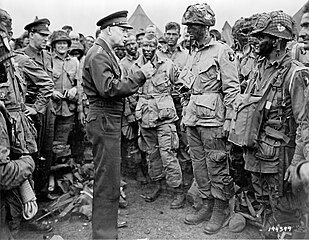
In December 1943, President Roosevelt appointed Eisenhower as the Supreme Allied Commander in Europe. He would also dually serve as the Supreme Allied Commander of the Allied Expeditionary Force. This is where Eisenhower would coordinate D-Day and the invasion of France & western Germany. The first thing that came to Eisenhower when he began in this position was planning a land invasion of Nazi territory in Europe, likely France. Before he could do this though, he first had to settle disputes with many people such as President Roosevelt as to what the future of the war would look like. Eisenhower also had to constantly reprimand George S. Patton, most notably when he once slapped two soldiers who were injured. Eisenhower then coordinated D-Day, and on June 5, 1944, a famous picture (shown above) was taken of Eisenhower talking to troops the day before the invasion. While D-Day was successful, it included a catastrophic loss of life. However, it would become one of Eisenhower's most famous actions. The invasion of Southern France would commence then two months later, and as Eisenhower got forces closer and closer to Germany, Eisenhower would witness the early stages of the Cold War. Eisenhower knew he had to be careful with the Soviet Union, who was invading Germany from the East. While Britain wanted to race to the German capitol of Berlin, Eisenhower refused, saying that he would not do so unless explicitly ordered. Back in Washington, it was ordered that no military action be made to oppose the Soviets, essentially putting an end to any of Britain's propositions. After Germany surrendered to the Allies, Eisenhower became the military governor of the American sector of the country. A key objective was to not punish the Germans like what was done after World War I, but to instead help the Germans regain their footing while censoring any references to the Nazis. Eisenhower would play a key role in the strategy, making sure American food, resources and medical equipment were adequately circulated throughout the sector.
In November 1945, around six months after the end of WWII in Europe, Eisenhower returned to become the Army Chief of Staff. During his tenure, his main goal was to deal with the rapid demobilization of troops that were coming home after war, which was beginning to spiral out of control. Eisenhower was also in favor of the United Nations and the control over nuclear weapons. In fact, he even originally opposed the atomic bombing of Japan at the end of World War II. Eisenhower also originally believed in allying with the Soviet Union, saying that the countries should remain at peace. He promoted this by visiting Warsaw, Poland, in late 1945, which was under control of the Soviets.
In 1948, Eisenhower became president of Colombia University. While I won't go into detail of his term at the university, it was during this time that Eisenhower released his memoir, Crusade in Europe. This was a huge financial success for Eisenhower. When Eisenhower requested to resign as president of the university, it was refused. Eisenhower would eventually officially resign one day before his presidential inauguration in 1953.
In 1950, Eisenhower served a short stint as the Supreme Commander of NATO forces in Europe. Eisenhower would promote the military alliance at home quite a bit, though he believed it would eventually become a exclusively European alliance, with the United States and other non-European countries leaving after around a decade. Eisenhower retired as a full-time military general on June 3, 1952.
Eisenhower was once asked by a politician to consider running for president in the 1948 United States presidential election. Eisenhower refused, though, stating that an Army general should stay out of political affairs. President Harry Truman reportedly told Eisenhower that if he wanted to, Truman would help Eisenhower win the election. In 1947, Truman also stated that if General MacArthur were to win the Republican presidential nomination, that Truman would be Eisenhower's running mate for the Democrats. Of course, Eisenhower once again refused. In the 1948 election, Truman would end up winning re-election against Republican Thomas Dewey.
In 1951, President Truman once again went to Eisenhower trying to convince him to run for the Democratic nomination for the presidency the next year, which Eisenhower would most likely win. Eisenhower refused, though not because of political affairs, but because he disagreed with the Democratic party. He then declared himself as a Republican. As soon as this was known, a widespread movement in the Republican party began to persuade Eisenhower to run for president. This movement was known as "Draft Eisenhower". After a difficult time convincing Eisenhower to run, he was finally convinced, causing him to retire from his NATO position, and campained full-time. Though it was contested, Eisenhower won the Republican nomination, and eventually defeated Adlai Stevenson II in the 1952 presidential election. Eisenhower's vice president was future president Richard Nixon.
Eisenhower's relationship with Truman had disintegrated due to the campaining of 1952. Therefore, the transitioning of power was not discussed as much. With Eisenhower's staff being much larger than other presidents, the transitional process was more widespread. Eisenhower met with other political figures in late 1952 in Pearl Harbor to discuss the objectives of Eisenhower's presidency. In summary, these objectives were improving the economy and worker's rights, as well as ending the Korean War. Eisenhower was the first President-Elect to host a Cabinet meeting before his presidency began. Eisenhower became president of the United States on January 20, 1953.
Eisenhower's economic policies were similar to those of William Howard Taft. He believed in letting the economy do its own thing and balancing the budget. This proved to be a success as during his presidency, unemployment and inflation remained very low. While there were three short economic recessions during Eisenhower's presidency, these are generally not contributed to him. He kept most New Deal policies, the most major one being Social Security.
Throughout the 1950s, Joseph McCarthy, a Senator from Wisconsin, basically began the second Red Scare in the United States, and began targeting left-wing political associations. This part of American history, also known as McCarthyism, was infamous for imprisoning and, in extreme cases, execution of innocent people who were suspected of being Communists despite there being no true evidence. In private, Eisenhower expressed dislike of McCarthy, but knew that announcing it publicly would likely make him unpopular, as McCarthy was successfully able to scare the American people about Communism. Likely the most famous case of McCarthyism took place in the early 1950s when Julius and Ethel Rosenburg were suspected of being Communists and were later sentenced to death. Eisenhower refused to comment on the issue, and the couple was executed in 1953. Another case was that of J. Robert Oppenheimer, an agent in the Atomic Energy Commission (AEC), whom McCarthy framed as a Communist. Though Eisenhower did not believe the claims, he prevented Oppenheimer from anything related to national defense, and in a court case, Oppenheimer was stripped of his security clearance.
In 1948, President Truman had desegregated the US military. Though Eisenhower got a lot of votes from the South, he made sure to end resistance to the policy Truman had carried out. He also sought to make sure government job hiring was not discriminating against African-Americans. However, Eisenhower was not interested in desegregating schools or expanding voting rights. He once had a black advisor who would sometimes speak to Eisenhower, but recalled that the president did not seem interested in learning about the lives of African-Americans. After the famous court case Brown v. Board of Education which ended segregation in schools, Eisenhower privately said that ""These are not bad people [referring to the Southern whites]. All they are concerned about is to see that their sweet little girls are not required to sit in school alongside some big overgrown Negroes." In 1957, one of the most famous events happened in Civil Rights history when nine students were prohibited from entering a high school in Little Rock, Arkansas. The governor of the state ordered that the Arkansas National Guard be deployed to block the students from entering, "for their own safety". Eisenhower overruled the governor, though, and deployed federal troops to protect the black students outside and inside the school. Though many think this is a sign of Eisenhower explicitly supporting the Civil Rights Movement, it is more likely he did it in order to avoid international humiliation.
In 1956, Congress passed the Federal Aid Highway Act. Eisenhower publicly supported a national highway, and appointed Lucius Clay to coordinate the project. It would become a huge success and reached the entire country. It remains one of the greatest highlights of Eisenhower's presidency.
In 1956, Eisenhower sought re-election. He had a rematch with his 1952 opponent, Adlai Stevenson II, in the most recent presidential rematch to date. He easily won re-election, winning more states and being able to sway voters by talking about his presidential accomplishments, not even needing to bring up his prior military record.
In 1950, the Korean War began between the Communist north and Democratic south. By 1953, though, the war was dragging on in a stalemate. Eisenhower, who had visited the peninsula in late 1952, realized this, and sought a quick way to end the conflict. He considered the nuclear option, but he was persuaded not to. Eventually, though, both sides signed an armistice to end fighting and the war came to a close. After the armistice, though, tensions increased between the United States and China. Though China was now a Communist nation, Eisenhower continued to recognize the Republic of China as the country's official government. The two countries remained at odds with each other, as Eisenhower wanted to contain Communism. In 1954, the Sino-American Treaty was signed between the two nations, though Eisenhower made sure that if something were to happen, he would make sure appropriate forces would be acted on against China. He was later urged to use the nuclear bomb against the nation, but he refused, as he considered himself successful with keeping peace while containing a Communist nation.
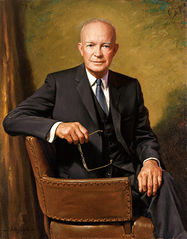
Though the Vietnam War is more closely tied to Eisenhower's three immediate successors, it technically started under him. At the time, Vietnam was known as French Indochina, as France ruled the land. Communists forces, backed by China, began to rebel against the French, and Eisenhower immediately saw it as a possible Communist takeover. Quietly, Eisenhower sent bombers, advisors and military aid to the French, which increased as his presidency went on. As his presidency ended, he told his successor John F. Kennedy about the conflict.
At the very beginning of his presidency, Eisenhower authorized the CIA to essentially overthrow the Prime Minister of Iran, causing much of the country's oil to fall into the hands of the United States and Britain.
In 1956, the forces of Israel, France and Britain invaded Egypt as a response to the Suez Crisis, in which the nations wanted to regain control of the Suez Canal. In November of the same year, Eisenhower condemned and forced the invasion to end, and it won him the support of Egypt's citizens and the government. Shortly after, Eisenhower declared the Eisenhower Doctrine, which said that the United States would support any government in the Middle East that allied themselves to the United States; it was used many times in countries such as Lebanon and Jordan, in one case sending 15,000 marines.
Of course, the relations with the Soviet Union are definitely the biggest highlight of Eisenhower's foreign policy.
In 1957, the Soviet Union released the first ever space satellite, known as Sputnik. Though it was known before by Eisenhower that the Soviets had capabilities for space, it was not until after the launch of Sputnik that Eisenhower began to take space seriously, in what would become the Space Race. The Space Race was a contest between the two nations to reach space, with one objective being to reach the moon. Immediately, Eisenhower began to promote science throughout the nation, and met with American scientists. He also created NASA in October 1958. Of course, fear spread throughout the nation, and Eisenhower sought to create a defensive satellite against the Soviets. Privately, he did not think fondly of huge space projects, especially those that would send humans to outer space.
The highlight of American-Soviet relations under Eisenhower's presidency was likely when an American U-2 spy plane in the Soviet Union was shot down by Soviet forces in 1960. Originally, the United States said the plane was a weather plane for NASA, but ended up admitting about it being a spy plane. Many photos of Soviet military bases were on the plane, and it prompted the Soviets to sentence the pilot to three years in prison and seven years of hard labor. The pilot would later be returned to the US after two years in a prisoner exchange.
Due to the 22nd amendment, Eisenhower was the first president that was constitutionally banned from seeking a third term. In the 1960 election, Eisenhower backed his vice president, Richard Nixon and did not like John F. Kennedy. Kennedy would end up barely winning the election, though, and he would become Eisenhower's successor. Eisenhower would leave office on January 20, 1961. During the events that unfolded during JFK's presidency (specifically the Cuban Missile Crisis), he would ask Eisenhower for advice. There exists pictures of them talking about certain matters, as a matter of fact. During his presidency, Eisenhower had several heart attacks during his presidency and post-presidency, and even suffered a stroke during a cabinet meeting. He also chain-smoked, at once smoking three-four packs a day. In political matters, Eisenhower remained in them, speaking at the 1964 Republican National Convention and appearing in a Barry Goldwater campain commercial. Eisenhower also happily saw his vice president, Richard Nixon, be elected in 1968.
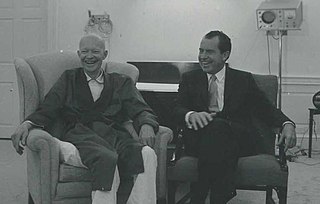
Unfortunately, despite Eisenhower being in relatively good health near the end of his life, his heart problems still caught up with him. He died on March 28, 1969 in Washington, D.C., in the Walter Reed Medical Center. He died from congestive heart failure. Following his death, a funeral carriage would go all the way back to his home town in Abilene, Kansas. President Richard Nixon gave Eisenhower's eulogy.
Eisenhower is considered to be one of the greatest military commanders of all time. He led forces into Northern Africa, Italy, and took charge of the invasion of Nazi Germany. Eisenhower was a vital man who most certainly helped in changing the tide of the war.
With such a notable military career, his presidency is commonly overshadowed. However, unlike most presidents who have been forgotten by most, Eisenhower's wasn't due to the fact that his presidency was bad, but rather that he was president in a time of post-war prosperity, and there was not much to do, other than fueling the Cold War with the Soviets. His presidency can be compared to that of Calvin Coolidge, in which they both were president during a time of post-war prosperity and there was not much that needed to be done.
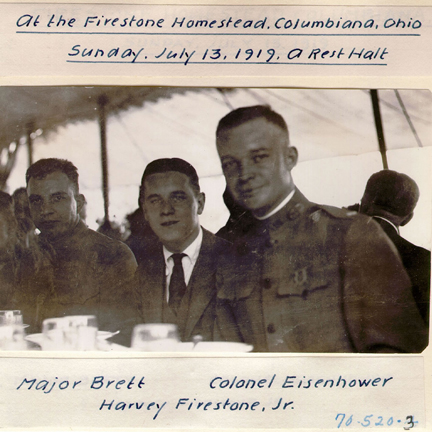
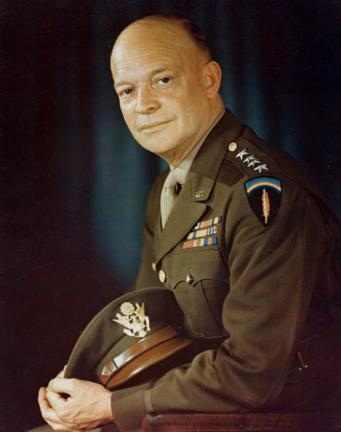

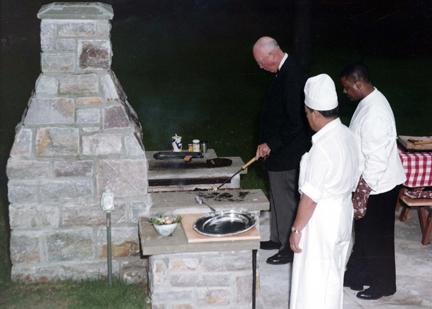
See page for author, Public domain, via Wikimedia Commons
Unknown U.S. Army photographer, Public domain, via Wikimedia Commons
James Anthony Wills, Public domain, via Wikimedia Commons
Robert L Knudsen, Public domain, via Wikimedia Commons
These are for images in the image gallery, listed from left to right
Eisenhower Library, public domain
Eisenhower Library, public domain, via the US Army
Eisenhower Library, public domain
TheUSAPresidents.com
About Us Legal Political policy Reliability
Information on this site should not be plagiarized. This site is intended for hobby purposes, not commercial. Visit here for more information.